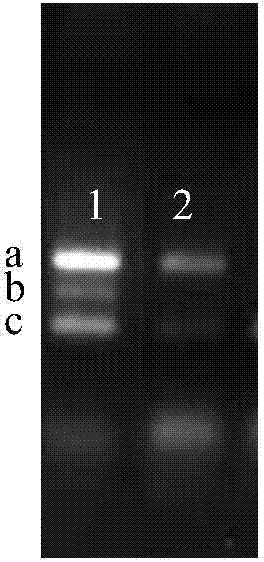Utilizing tem-pcr technology to detect a variety of pathogenic bacteria by pcr detection universal primer pair
A technology of technical detection and universal primers, which is applied in the field of PCR detection of universal primer pairs, can solve problems such as false negatives, achieve good amplification results, balance amplification efficiency, and solve the effects of false negative results
- Summary
- Abstract
- Description
- Claims
- Application Information
AI Technical Summary
Problems solved by technology
Method used
Image
Examples
Embodiment 1
[0044] Preparation of PCR template
[0045] According to the instruction manual of TIANamp Bacteria DNA Kit, various bacteria shown in Table 1 below were used as samples to extract and purify bacterial genomic DNA.
Embodiment 2
[0047] Primer design and synthesis
[0048] 1. Design and synthesis of non-homologous universal primers
[0049] Synthesize a pair of non-homologous universal primers (or super primers) to ensure that the pair of primers have no homology with bacteria and are non-homologous unique sequences. The primer sequences are as follows:
[0050] Super-F: AACTGTGTTTACTACTAGG;
[0051] Super-R: GGATTTAATGGCTACTTCTC.
[0052] 2. Design and synthesis of specific primers
[0053] Use the NCBI website and refer to relevant literature to select genes in the conserved regions of pathogenic bacteria.
[0054] Use the dnaman software to compare the nucleotide sequences of the conserved regions of three pathogenic bacteria, Enterohemorrhagic Escherichia coli O157:H7, Listeria monocytogenes, and Salmonella, to find out the nucleotide sequences that are more suitable for designing specificity sequence area. Determine the target gene of enterohaemorrhagic Escherichia coli O157:H7 is rfbE, the ...
Embodiment 3
[0065] Optimization of PCR Conditions for Detection of Various Pathogenic Bacteria by Tem-PCR
[0066]Firstly, several different concentrations of general primers and specific primers are set, and the concentration of primers is optimized through orthogonal experiments. Then set several pre-cycle numbers and post-cycle numbers, and optimize the Tem-PCR amplification cycle numbers through orthogonal experiments. Finally determine the PCR reaction conditions of Tem-PCR method detection multiple pathogenic bacteria as follows:
[0067]
[0068]
[0069] The PCR reaction conditions were: pre-denaturation at 94°C for 10 min; 94°C for 30 s, 62°C for 1.5 min, 10 cycles; 94°C for 30 s, 46°C for 30 s, 72°C for 30 s, a total of 35 cycles; 72°C for 5 min.
PUM
 Login to View More
Login to View More Abstract
Description
Claims
Application Information
 Login to View More
Login to View More - R&D
- Intellectual Property
- Life Sciences
- Materials
- Tech Scout
- Unparalleled Data Quality
- Higher Quality Content
- 60% Fewer Hallucinations
Browse by: Latest US Patents, China's latest patents, Technical Efficacy Thesaurus, Application Domain, Technology Topic, Popular Technical Reports.
© 2025 PatSnap. All rights reserved.Legal|Privacy policy|Modern Slavery Act Transparency Statement|Sitemap|About US| Contact US: help@patsnap.com



